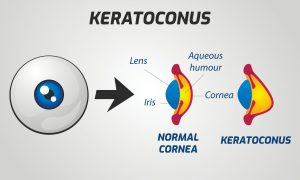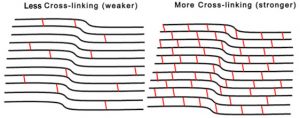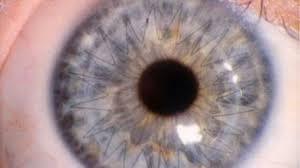Have you recently found out you have keratoconus? Keratoconus is a progressive eye condition that primarily affects children, teenagers, and young adults.
Because it develops over a long period, keratoconus may present minor symptoms at first. But over time, the eye condition can harm your eyes to the point that glasses and contact lenses can no longer correct your vision.
Luckily, keratoconus is treatable. There’s no cure, but there are ways to manage the condition to slow it down and stop its progression. But for the treatment to be effective, it needs to be done before significant damage occurs, as that damage may not be reversible.
What is Keratoconus?

Keratoconus occurs when the clear, front part of your eye, called the cornea, thins and stretches out. As it gets thinner, it begins to bulge and takes on a cone-like shape and appearance.
The cornea is an integral part of your eye as light passes through it and refracts before hitting your retina. When the cornea is not consistent in shape, the light can’t refract through it properly.
As a result, the things you see will appear blurry and distorted. If you have a refractive error like nearsightedness, farsightedness, or astigmatism, you’ll have blurry vision.
But these refractive errors cause the tiniest irregularities in the cornea. Keratoconus can cause much more extensive problems with your vision and how you see the more the cornea stretches out.
While keratoconus can happen to anyone, it’s much more common in patients between 10 and 25 years old. The exact cause of keratoconus is unknown, but it’s linked with genetics, certain medical conditions, and frequent eye rubbing.
How to Diagnose Keratoconus

Keratoconus symptoms include blurry vision, light sensitivity, and the urge to rub your eyes. If you or your child experiences these symptoms, make an appointment with your eye doctor as soon as you can. Try not to rub your eyes or let your child rub their eyes as this can cause the condition to progress faster.
An ophthalmologist can diagnose keratoconus and recommend treatment. If your regular eye doctor isn’t an ophthalmologist, they can still spot the signs of the condition and refer you to one.
At Williamson Eye Center, we offer our patients a specialized Keratoconus Treatment Center in Baton Rouge. Our center features corneal cross-linking, an FDA-approved keratoconus treatment that helps slow down the progression of the eye condition.
It’s essential to see an eye doctor regularly, especially if you’re still under 18, as your vision changes faster when you’re growing and developing. Your eye doctor may pick up on the signs of keratoconus before you can recognize the symptoms.
Scheduling regular eye exams can help diagnose and treat the condition as early as possible.
Treatment for Keratoconus
There are a few forms of treatment for keratoconus. Strong glasses and contact prescriptions may be enough to correct a patient’s vision in the early stages.
Specialty Contact Lenses
Because the cornea is an irregular shape when you have keratoconus, specialty contact lenses may be the best way to go. These include scleral lenses, rigid gas permeable lenses (RGP), or hybrid contact lenses.
Specialty contact lenses are specially designed to fit over the cone-like shape of the eye. These lenses can help you see, but they won’t stop the cornea from protruding further. However, some treatments can.
Corneal Cross-Linking

The most effective treatment for keratoconus is called corneal collagen cross-linking. Corneal cross-linking strengthens the cornea so it won’t stretch out further.
The procedure is minimally invasive, using UVA light and riboflavin (vitamin B2) to strengthen and stiffen the cornea. Riboflavin is a photo enhancer, allowing the cross-linking reaction to occur.
The light activates the riboflavin and strengthens the bonds between collagen fibers in the cornea. Stronger collagen fibers make it harder for the cornea to continue weakening and protruding.
However, collagen cross-linking cannot reverse any stretching to the cornea that has already occurred. Even after receiving this treatment, you’ll likely continue needing special contact lenses, depending on the progression of your keratoconus.
Intacs
Another form of treating keratoconus is using implants called Intacs. Intacs are placed in the eye, making it harder for the cornea to continue stretching out.
Intacs are very small, arc-shaped bracers surgically placed within the cornea. These implants stretch the cornea and make it easier to wear regular contact lenses if your bulging cornea has made it difficult to tolerate wearing contact lenses.
If you have keratoconus, it will likely take a combination of treatments to improve your vision. Even with treatment, you’ll still need to use glasses or contact lenses.
Although you can slow down the progression of keratoconus, you can’t reverse any of the damage to the cornea. While you can alter the shape of the cornea slightly with Intacs, there’s no way to undo the thinning and stretching of the cornea.
Corneal Transplant

In more severe cases of keratoconus, a corneal transplant may be necessary. During a corneal transplant, part of the cornea gets replaced with corneal tissue provided by a donor.
As with any transplant, there is some risk of rejection or other complications. Although corneal transplants are usually successful, they are avoidable.
It’s best to treat keratoconus in its earliest stages. Using innovative treatments like corneal cross-linking can help manage and slow down the further progression of keratoconus.

Do you need more information about how to treat keratoconus? Schedule an appointment at Williamson Eye Center’s Keratoconus Treatment Center in Baton Rouge, LA, now!
You don’t have to manage keratoconus on your own. Why not trust the experts and preserve your vision?



